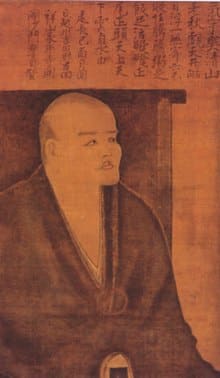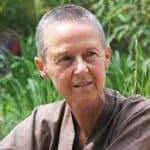Fukanzazengi
Zazen for anyone anywhere

From the beginning the Way is universal and complete, so why do we distinguish between practice and enlightenment? The Dharma-vehicle is naturally present of itself, freely already here. So why do we need to make an effort to realize it? As the whole body of reality is beyond the dust of illusion, who then is the one that believes we need to sweep this dust away? Never separate, it is always right where you are, so what is the use of practising this and that?
If there is a hair’s breadth discrepancy, the Way is as distant as heaven is from earth. If the slightest like or dislike arises, the Buddha mind slips out of sight through confusion. For example, when you are proud of your understanding, or think you are greatly enlightened, or have acquired wisdom and abilities, or mastered the Way and clarified what you are, or have grasped the will to storm heaven – you have made a head-start but the vital way to free the body is almost lost.
Shakyamuni had great wisdom at birth and we still see clearly the imprint of his sitting upright for six years. Bodhidharma transmitted the Buddha mind- seal and his nine years sitting facing a wall still echoes today. As the sages of ancient times were so dedicated, how can trainees of the present day possibly dispense with such effort?
Therefore, rest from following words and narratives, and learn the backward step of turning the light within, illuminating the Mind. When you do so, body and mind will drop away naturally and your original countenance will manifest. If you want to realize the matter of this, devote attention to the matter of this at once. Explore zazen in a quiet room and eat and drink moderately. Let all involvements and all activity come to rest. Do not think in terms of good or bad, or judge in terms of right or wrong. Cease the grinding of the conscious mind and the gauging of thoughts and views. Do not try to become Buddha. This inquiry does not depend whatsoever on sitting or lying down.
Place a thick mat at your usual sitting place with a round sitting-cushion on top of it. Sit in either the full lotus position or in the half lotus position. For the full lotus position, place first your right foot on your left thigh and then your left foot on your right thigh. For the half lotus position, just rest the left foot on top of the right thigh. Wear your clothing loose around the waist and arrange it neatly. Then rest the right hand on the left foot and the left hand on the right palm, the tips of the thumbs supporting each other*.
Sit upright, without leaning to the left or right, backward or forward. Let the ears be in line with the shoulders and the nose in line with the navel. Let lips and teeth close, with the tongue held against the palate behind the top teeth. Keep the eyes open and breathe gently through the nose. When the body is settled, breathe in and exhale fully and sway the body left and right. Then sit immovably in original stillness. Think the fundamental ‘thought’, which is not thinking. How? When thought arises, do not get involved with it; let the mind dwell in the depth beyond thought. This is the very basis of zazen. This zazen is not learning concentrated meditation. It is simply the Dharma-gate of peace and joy, the realisation in practice of enlightened wisdom. The universal is revealed through the particular without means. Once you grasp this, you are like a dragon disporting in water or like a tiger reposing on a mountain. You naturally know that the true Dharma manifests of itself and that darkness and confusion have already been cut down.
When you arise from meditation, move slowly and get up calmly; don’t move abruptly. It is clear that the ability to transcend the profane as well as the sacred, or to cast off body and mind while sitting or standing, is entirely due to the efficacy of zazen. Also, the discriminating mind cannot understand how a shift in perspective can come with a gesture or an occurrence; or how an unexpected sight or sound can catalyse realisation**. With accomplished supernatural powers one cannot grasp this either. Such noble presence is not bound to form or colour. How could its pathway possibly not precede perception and conception? It therefore does not matter whether you are intelligent or not; it does not work differently for the sharp- or for the dull-witted. Making a wholehearted effort is in itself practising the Way. Practice has naturally the purity of enlightenment and enlightenment will increasingly penetrate your everyday life.
The fundamental Buddha mind universally pervades both this and other worlds, India and China, East and West. Everywhere the way of practice of this school is equally available to everyone, as it is simply sitting immovably in original stillness with one’s whole being. Although there are many different ways to approach the Truth, to verify it you cannot dispense with the earnest inquiry of zazen. Why roam through dusty realms of other lands, forsaking your own sitting place? One wrong step and you are immediately off track. You already have the crucial opportunity a human body brings. Do not use your time in vain but guard the essence of the Buddha way. Who could be satisfied with fleeting pleasures? This human form is as short-lived as dew on the grass. Like a flash of lightning this life comes and goes in a moment, gone as if it had never been.
Dedicated practitioners, do not get so used to partial reality and to seeming appearances that reality ends up scaring you***. Devote yourself to the upright, direct way. Respect those who have severed the ties of knowledge and live free of goal and intent. Harmonize with the Buddha’s enlightened wisdom; receive the ancestors’ transmission of samadhi. When you practise this continually, you will surely become this; the store of treasure will then open naturally and you will be able to receive and use it, according with and fulfilling the true wish.
* – This paragraph and the beginning of the next is identical to instructions in a Chinese Manual (Zuo Ch’an Yi) about how to do zazen.
** – This is a shortened version of: Also, the discriminating mind cannot understand how a shift in perspective can come when a finger is pointed, a flagpole is cut down, a needle is immersed in water or when a mallet strikes a wooden block; or how a flicking hossu, raised fist, thumping staff or loud shouts can bring about realisation.
*** – The apparent and partial are indicated through the image of an elephant, referring to the story of several blind men who touched a part of an elephant and tried to describe the whole being on basis of the part they touched. Reality is by Dogen expressed through the image of a dragon, also referring to a Buddhist story.
Author: Zenmaster Dōgen Zenji


